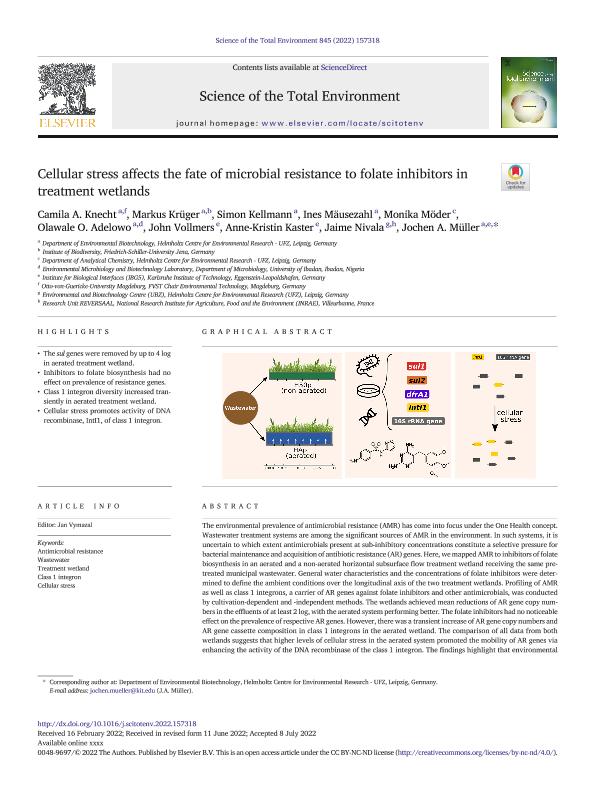Mostrar el registro sencillo del ítem
dc.contributor.author
Knecht, Camila Ayelén

dc.contributor.author
Krüger, Markus
dc.contributor.author
Kellmann, Simon
dc.contributor.author
Mäusezahl, Ines
dc.contributor.author
Möder, Monika
dc.contributor.author
Adelowo, Olawale O.
dc.contributor.author
Vollmers, John
dc.contributor.author
Kaster, Anne-Kristin
dc.contributor.author
Nivala, Jaime
dc.contributor.author
Müller, Jochen A.
dc.date.available
2023-08-18T18:34:02Z
dc.date.issued
2022-11
dc.identifier.citation
Knecht, Camila Ayelén; Krüger, Markus; Kellmann, Simon; Mäusezahl, Ines; Möder, Monika; et al.; Cellular stress affects the fate of microbial resistance to folate inhibitors in treatment wetlands; Elsevier; Science of the Total Environment; 845; 11-2022; 1-10
dc.identifier.issn
0048-9697
dc.identifier.uri
http://hdl.handle.net/11336/208776
dc.description.abstract
The environmental prevalence of antimicrobial resistance (AMR) has come into focus under the One Health concept. Wastewater treatment systems are among the significant sources of AMR in the environment. In such systems, it is uncertain to which extent antimicrobials present at sub-inhibitory concentrations constitute a selective pressure for bacterial maintenance and acquisition of antibiotic resistance (AR) genes. Here, we mapped AMR to inhibitors of folate biosynthesis in an aerated and a non-aerated horizontal subsurface flow treatment wetland receiving the same pre-treated municipal wastewater. General water characteristics and the concentrations of folate inhibitors were determined to define the ambient conditions over the longitudinal axis of the two treatment wetlands. Profiling of AMR as well as class 1 integrons, a carrier of AR genes against folate inhibitors and other antimicrobials, was conducted by cultivation-dependent and -independent methods. The wetlands achieved mean reductions of AR gene copy numbers in the effluents of at least 2 log, with the aerated system performing better. The folate inhibitors had no noticeable effect on the prevalence of respective AR genes. However, there was a transient increase of AR gene copy numbers and AR gene cassette composition in class 1 integrons in the aerated wetland. The comparison of all data from both wetlands suggests that higher levels of cellular stress in the aerated system promoted the mobility of AR genes via enhancing the activity of the DNA recombinase of the class 1 integron. The findings highlight that environmental conditions that modulate the activity of this genetic element can be more important for the fate of associated AR genes in treatment wetlands than the ambient concentration of the respective antimicrobial agents. By extrapolation, the results suggest that cellular stress also contributes to the mobility of AR gene in other wastewater treatment systems.
dc.format
application/pdf
dc.language.iso
eng
dc.publisher
Elsevier

dc.rights
info:eu-repo/semantics/openAccess
dc.rights.uri
https://creativecommons.org/licenses/by-nc-nd/2.5/ar/
dc.subject
ANTIMICROBIAL RESISTANCE
dc.subject
CELLULAR STRESS
dc.subject
CLASS 1 INTEGRON
dc.subject
TREATMENT WETLAND
dc.subject
WASTEWATER
dc.subject.classification
Biotecnología Medioambiental

dc.subject.classification
Biotecnología del Medio Ambiente

dc.subject.classification
INGENIERÍAS Y TECNOLOGÍAS

dc.title
Cellular stress affects the fate of microbial resistance to folate inhibitors in treatment wetlands
dc.type
info:eu-repo/semantics/article
dc.type
info:ar-repo/semantics/artículo
dc.type
info:eu-repo/semantics/publishedVersion
dc.date.updated
2023-08-02T17:56:54Z
dc.journal.volume
845
dc.journal.pagination
1-10
dc.journal.pais
Países Bajos

dc.journal.ciudad
Amsterdam
dc.description.fil
Fil: Knecht, Camila Ayelén. Consejo Nacional de Investigaciones Científicas y Técnicas. Oficina de Coordinación Administrativa Houssay. Instituto de Investigaciones en Microbiología y Parasitología Médica. Universidad de Buenos Aires. Facultad de Medicina. Instituto de Investigaciones en Microbiología y Parasitología Médica; Argentina. Otto-von-Guericke-Universität Magdeburg; Alemania. Helmholtz Centre for Environmental Research; Alemania
dc.description.fil
Fil: Krüger, Markus. Helmholtz Centre for Environmental Research; Alemania. Universitat Jena; Alemania
dc.description.fil
Fil: Kellmann, Simon. Helmholtz Centre for Environmental Research; Alemania
dc.description.fil
Fil: Mäusezahl, Ines. Helmholtz Centre for Environmental Research; Alemania
dc.description.fil
Fil: Möder, Monika. Helmholtz Centre for Environmental Research; Alemania
dc.description.fil
Fil: Adelowo, Olawale O.. Helmholtz Centre for Environmental Research; Alemania. University Of Ibadan; Nigeria
dc.description.fil
Fil: Vollmers, John. Karlsruher Institut für Technology; Alemania
dc.description.fil
Fil: Kaster, Anne-Kristin. Karlsruher Institut für Technology; Alemania
dc.description.fil
Fil: Nivala, Jaime. Helmholtz Centre for Environmental Research; Alemania. National Research Institute for Agriculture; Francia
dc.description.fil
Fil: Müller, Jochen A.. Helmholtz Centre for Environmental Research; Alemania. Karlsruher Institut für Technologie; Alemania
dc.journal.title
Science of the Total Environment

dc.relation.alternativeid
info:eu-repo/semantics/altIdentifier/url/https://www.sciencedirect.com/science/article/pii/S0048969722044163
dc.relation.alternativeid
info:eu-repo/semantics/altIdentifier/doi/http://dx.doi.org/10.1016/j.scitotenv.2022.157318
Archivos asociados
